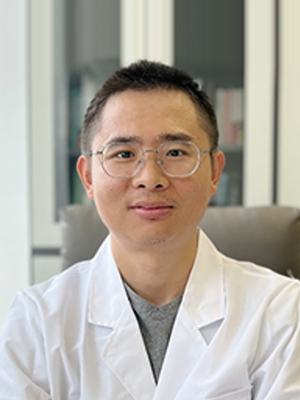
Principal Investigator
Biochemistry & Molecular Biology
wuchao@szbl.ac.cn
2023-PresentShenzhen Bay Laboratory Junior Principal Investigator
2019-2023 Department of Pathology and Immunology, Washington University in St. Louis Postdoctoral Researcher, Instructor
2016-2019Postdoctoral Fellow in Pathology and Immunology at Washington University in St Louis
2011-2016PhD in Computational & Molecular Biophysics, Washington University in St Louis
2008-2011 National Institute of Biological Sciences, Beijing Research Assistant
2005-2008Bachelor of Science in Life Science Honors Program, China Agricultural University
Taking advantage of highly interdisciplinary background, my ultimate goal is to advance biological research by formulating our understanding of subcellular, cellular, and multicellular systems in quantitative models underpinned by rigorous principles of physical sciences and translate insights frombasic sciences for public benefit. Specifically, I am particularly interested in replication and immune evasion mechanisms of viruses. This is because viruses are obligate intracellular parasites; every solution of these evolutionary tug-of-wars must reveal something about the host as well as the virus. Intriguingly, with limited coding capacity, viruses often achieve productive replication and immune evasion through multifunctional proteins that play complex roles in both processes. Delineating how these multifunctional proteins mediate replication and immune evasion advances our understanding about how the body's immune system responds to infectious diseases and sheds light on vaccine and treatment developments.
My trainings span a wide spectrum of disciplines from computational chemistry to virology because I firmly believe the power of interdisciplinary approaches in scientific breakthroughs. During my postgraduate studies with Professor Niu Huang at the National Institute of Biological Sciences, Beijing, I performed modeling studies as well as computer aided drug design. My work focused on modeling protein dynamics and virtual screening against novel cancel targets. My PhD training in Computational and Molecular Biophysics at Washington University in St. Louis School of Medicine transitioned me into experimental studies of membrane protein dynamics using nuclear magnetic resonance. During my training, I undertook protein structure-dynamics-function relationship studies of multidrug resistance transporter that shed light on transport mechanism and multidrug recognition mechanism. My postdoctoral work in Department of Pathology and Immunology at Washington University in St. Louis has been aimed at filoviral replication and immune evasion mechanisms using a combined biochemical and virological approach. In this, I integrated an arsenal of particle characterization techniques, including light scattering, EM, and MS, to develop a series of assays for viral nucleocapsid whose remodeling is key to both replication and immune evasion. Not only has my work led to a conceptual framework of nucleocapsid remodeling from chaperoned state to assembled state critical for replication and assembly, it points to therapeutic potential of perturbing nucleocapsid remodeling kinetics and thermodynamics to achieve antiviral and immune modulatory benefits simultaneously. My series work in collaboration through multiple NIH grants led to several advancements in Ebola replication complex characterization as well as therapeutic development against key interfaces with NMR fragment screening. Another branch of my work has led to systematic study of SARS-CoV-2 for enhanced specific and sensitive serology marker. Collaborative studies have been able to use a multiplex assay to screen patient serological responses to SARS-CoV-2 with as little as a microliter of plasma. Because of deep interest and commitment, my research career is highly productive with 18 publications in top-notch journals such as Annual Review of Virology, Cell, iScience, Nature Immunology, JMB, and Nature Comm. etc. Besides my research accomplishments, I have written invited review and commentary, reviewed extensively for eLife, iScience, Viruses, Journal of Medical Virology, Vaccines, etc, and currently serves as a guest editor for Vaccines. Throughout my scientific training, I embraced the opportunity to teach and mentor trainees (over 10 from undergraduates to postdocs). As a result, I was promoted to instructor after three years of postdoc. I am looking forward to developing cross-disciplinary curriculum for trainees that combine biophysics, biochemistry, and virology.
C. Wu*, N. Wagner, A. B. Moyle, A. Feng, N. Sharma, S. H. Stubbs, C. Donahue, R. Davey, M. L. Gross, D. W. Leung*, and G. K. Amarasinghe*. Disruption of Ebola NP0VP35 Inclusion Body-like Structures Reduce Viral Infection. Journal of Molecular Biology, 2023, Aug 18; 168241.
C. Wu, A. S. Holehouse, D. W. Leung, G. K. Amarasinghe, R. E. Dutch. Liquid phase partitioning in virus replication: observations and opportunities. Annual Review of Virology, 2022. 9:23.
A. J. Qavi, C. Wu, M. Lloyd, M. M.-U. Zaman, J. Luan, C. Ballman, D. W. Leung, S. L. Crick, G. K. Amarasinghe, and C. W. Farnsworth. Plasmonic Fluor-Enhanced Antigen Arrays for High-Throughput, Serological Studies of SARS-CoV-2. ACS Infectious Diseases. 2022, 8, 8.
Q. Ming, D. P. Celias, C. Wu, A. R. Cole, S. Singh, C. Mason, S. Dong, T. H. Tran, G. K. Amarasinghe, B. Ruffell, V. C. Luca. LAG3 ectodomain structure reveals functional interfaces for ligand and antibody recognition. Nature Immunology, 2022. 1-11.
C. Wu, A.J. Qavi, A. Hachim, N. Kavian, A.R. Cole, A.B. Moyle, N.D. Wagner, J. Sweeney-Gibbons, H.W. Rohrs, M.L. Gross, J.S.M. Peiris, C.F. Basler, C.W. Farnsworth, S.A. Valkenburg, G.K. Amarasinghe, D.W. Leung. Characterization of SARS-CoV-2 N protein reveal multiple functional consequences of the C-terminal domain. iScience. 2021, 24, 201681
W. Wang#, C. Wu#, G.K. Amarasinghe, D.W. Leung. Ebola virus replication stands out. Trends in Microbiology. 2019, 27(7), 565-566. (# co-first author)
C. Wu, S.A. Wynne, N.E. Thomas, E.-M. Uhlemann, C.G. Tate, K. Henzler-Wildman. Identification of an alternating-access dynamics mutant of EmrE with impaired transport. Journal of Molecular Biology. 2019, 431(15), 2777-2789.
Z. Su#, C. Wu#, L. Shi, P. Luthra, G.D. Pintilie, B Johnson, J.R. Porter, P. Ge, M. Chen, G. Liu, T. E. Frederick, J.M. Binning, G.R. Bowman, Z. Zhou, C. Basler, M.L. Gross, D.W. Leung, W. Chiu, and G.K. Amarasinghe. Electron cryo-microscopy structure of Ebola nucleoprotein reveals a mechanism for nucleocapsid-like assembly. Cell. 2018, 172: 1-13 (# co-first author)
N. Thomas, C. Wu, E. Morrison, A. Robinson, J. Werner, K. Henzler-Wildman. The C-terminus of bacterial multidrug transporter EmrE couples drug binding to proton release. Journal of Biological Chemistry. 2018, 293(49): 19137.
Y. Zhou, C. Wu, L. Zhao, N. Huang. Exploring the early stages of the pH-induced conformational change of influenza hemagglutinin. Proteins. 2014, 82: 2412-2428.